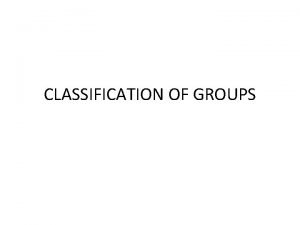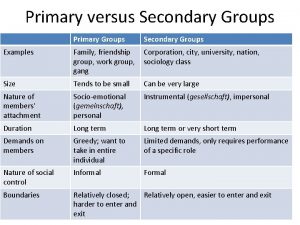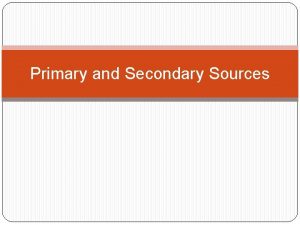Groups Primary and Secondary Groups Categories and Aggregates


















- Slides: 18

Groups

Primary and Secondary Groups, Categories, and Aggregates • A group consists of at least two people who share one or more goals and think, feel, and behave in similar ways. • Members of a group are in regular contact with one another and take one another’s behavior into account. • Groups play important roles in the lives of their members, as well as influencing society. • Groups range from small and informal to large and formal and tend to create insiders and outsiders. • A group is not the same as a social category (people who share a social characteristic) or a social aggregate (people who happen to be in the same place at the same time).

Primary and Secondary Groups Primary Groups • A primary group is composed of people who are emotionally close, know one another well, and seek one another’s company. • They are characterized by primary relationships that are intimate, personal, caring, and fulfilling, and members feel responsible for one another. • They are the most important setting for socializing. • Conditions that help primary groups and primary relationships form include small group size, face-toface contact, continuous contact, and the proper social environment. • Primary groups serve three important functions in society: emotional support, socialization, and encouragement of conformity.

Primary and Secondary Groups • A secondary group is impersonal, goal oriented, and exists to accomplish a specific purpose. • Members’ responsibilities involve making contributions toward the group’s goal, but those contributions only affect a limited segment of members’ lives. • Members of secondary groups interact impersonally in secondary relationships. • Although primary relationships are more likely to occur in primary groups and secondary relationships in secondary groups, many secondary groups include some primary relationships.

Other Groups and Networks Reference Groups • People use reference groups to evaluate themselves and to acquire attitudes, values, beliefs, norms, and mores. • A person may consider a group to be a reference group without being a member. • Reference groups do not have to be positive models since observing the behavior of a group you dislike may reinforce a desire to act and feel differently. • An in-group requires extreme loyalty from its members. The in-group competes with and is opposed to an out-group. • In-groups must have boundaries to tell who is and is not “in. ” Maintaining group boundaries requires intense loyalty and commitment from members.

Other Groups and Networks Social Networks • All relationships make up a person’s social network, which is the web of social relationships that join a person to other people and groups. • The Internet has expanded interaction and the flow of information within networks. • A social network is not a group because it lacks the boundaries of a group, and it does not involve close or continuous interaction among all members. • Since social networks include both primary and secondary groups, the social relationships within a network involve both strong and weak ties. • Social networks can provide a sense of belonging and purpose, furnish support in the form of help and advice, and be a tool for entering the labor market.

Group Interaction

Types of Social Interaction Cooperation • Cooperation is a form of interaction in which individuals or groups combine their efforts to reach a goal. • Cooperation often occurs during a crisis when the single goal is physical survival or meeting basic physical needs. • Non-crisis examples of cooperation include establishing rules for recreational games, sharing the duties within a family, or working with a group to complete a task. • Without some degree of cooperation, social life could not exist.

Types of Social Interaction Conflict • In conflict, defeating the opponent is considered essential. • Although conflict is usually considered disruptive, it can be beneficial, depending on how it is handled. • Positive ways to handle conflict include persuasion, compromise, debate, and negotiation; these techniques allow each side to gain something from the conflict rather than having only a single winner. • One of the major benefits of conflict is the promotion of cooperation and unity within opposing groups. • Another positive effect of conflict is the attention it draws to social inequities, causing norms, beliefs, and values to be reexamined and even changed.

Types of Social Interaction Social Exchange • Social exchange is a type of social interaction in which one person voluntarily does something for another with the expectation of a reward in return. • With cooperation, individuals or a group work together to achieve a shared goal, while in social exchange the goal may be less important than the benefits to those involved. • Exchange relationships are often apparent in political and legislative maneuvering. • A common Latin phrase describing this type of exchange behavior is quid pro quo, or “this for that. ”

Types of Social Interaction Coercion • Coercion is social interaction in which individuals or groups impose their will on other individuals or groups. • Coercion is the opposite of social exchange. • Whereas social exchange involves voluntary actions for mutual benefit, coercion is a one-way street. • Social exchange occurs between groups or individuals roughly equal in power, while in coercion, one party is clearly dominant. • Conflict theory best describes this type of social interaction.

Types of Social Interaction Conformity • Conformity is behavior that matches group expectations. It is an expectation of socialization since social life could not exist without conformity. • Groupthink exists when thinking in the group is selfdeceptive, based on conformity to group beliefs, and created by group pressure. • In groupthink, pressures of uniformity discourage members from expressing their concerns. • Research shows that groupthink can be avoided when leaders or group members make sure everyone participates in the discussion and when members know that disagreement will be tolerated. • The “bystander effect” is when people in groups are hesitant to react differently than others.

Formal Organizations

Formal Organizations The Nature of Formal Organizations • A formal organization is deliberately created to achieve one or more long-term goals. • Formal organizations include educational institutions, business entities, government agencies, medical groups, religious bodies, political organizations, and fraternal societies and social clubs. • To manage their affairs, most formal organizations today are also bureaucracies, which are formal organizations based on rationality and efficiency.

Formal Organizations Major Characteristics of Bureaucracies • One characteristic of a bureaucracy is that it has a division of labor based on the principle of specialization. • Bureaucracies also have a hierarchy of authority structured like a pyramid, with the greatest amount of authority given to a few positions at the top. • Bureaucracies also have a system of rules and procedures. • Bureaucracies maintain written records of work and activities. • Bureaucracies promote workers on the basis of merit and qualifications rather than on favoritism.

Formal Organizations Max Weber and Bureaucracy • Weber feared the dehumanizing effects of bureaucracies, but as the values of preindustrial societies began to weaken, he also saw advantages to them. • A fast-moving industrial economy required steadiness, precision, continuity, speed, efficiency, and minimum cost, which are all advantages a bureaucracy could offer. • Bureaucracies reflect the mind-set of rationalization, which emphasizes knowledge, reason, and planning over tradition and superstition. • Although people often complain about the failings of bureaucracies, they are designed to protect individuals from arbitrary, illogical decision making, and favoritism.

Formal Organizations Informal Structures Within Organizations • Primary relationships emerge as part of informal organizations, or groups within a formal organization in which personal relationships are guided by norms, rituals, and sentiments that are not part of the formal organization. • Informal groups exist to meet needs ignored by the formal organization. • Informal groups offer personal affection, support, humor, and protection. • Informal organizations encourage conformity, but the resulting solidarity protects group members from mistreatment by those outside the group.

Formal Organizations Iron Law of Oligarchy • Individuals or smaller groups must exercise power for an organization to achieve its goals and sometimes this power may be grabbed by individuals for their own purposes. • The iron law of oligarchy states that power tends to become more and more concentrated in the hands of fewer members of any organization. • The first organizational factor that encourages oligarchy is that organizations need a hierarchy of authority to delegate decision making. • The second factor is that the advantages held by those at the top allow them to consolidate their power. • Finally, members of an organization tend to submit or defer to leaders.
 Primary vs secondary group
Primary vs secondary group Cooley classification of social groups
Cooley classification of social groups Rocks are aggregates of minerals
Rocks are aggregates of minerals Uce first grade aggregates
Uce first grade aggregates Sparse conditional constant propagation
Sparse conditional constant propagation Blending aggregates
Blending aggregates Grading of aggregates ppt
Grading of aggregates ppt Tests on aggregates ppt
Tests on aggregates ppt Gordon aggregates
Gordon aggregates Design compressive strength of concrete
Design compressive strength of concrete Ibas aggregates
Ibas aggregates How are ethnic groups and religious groups related
How are ethnic groups and religious groups related Primary and secondary effects of a tectonic hazard
Primary and secondary effects of a tectonic hazard Primary secondary stakeholders
Primary secondary stakeholders Primary pollutants and secondary pollutants
Primary pollutants and secondary pollutants Pinotubo
Pinotubo Use case primary and secondary actors
Use case primary and secondary actors Use case primary and secondary actors
Use case primary and secondary actors Maximum efficiency of transformer
Maximum efficiency of transformer



































